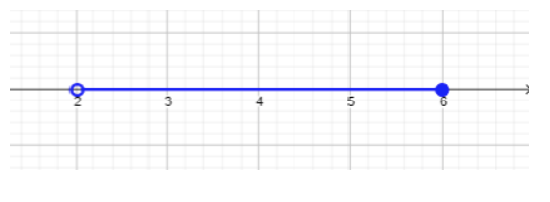10.2: Solving and Graphing Inequalities, and Writing Answers in Interval Notation
( \newcommand{\kernel}{\mathrm{null}\,}\)
To solve and graph inequalities:
- Solve the inequality using the Properties of Inequalities from the previous section.
- Graph the solution set on a number line.
- Write the solution set in interval notation.
Solve the inequality, graph the solution set on a number line and show the solution set in interval notation:
- −1≤2x−5<7
- x2+7x+10<0
- −6<x−2<4
Solution
- −1≤2x−5<7Example problem−1+5≤2x−5+5<7+5The goal is to isolate the variable x, so start by adding 5 to all three regions in the inequality.4≤2x<12Simplify.42≤2x2<42Divide all by 2 to isolate the variable x.2≤x<6Final answer written in inequality/solution set form.[2,6)Final answer written in interval notation (see section on Interval Notation for more details)

- x2+7x+10<0Example problem(x+5)(x+2)<0Factor the polynomial.(x+5)(x+2)<0The product must be less than 0, which means that if (x+5)>0, then (x+2)<0. Similarly, if (x+5)<0, then (x+2)>0.(x+5)>0∪(x+2)<0Find the intersection of each of these inequalities.x>−5∪x<−2Find the intersection of each of these inequalities.


−5<x<−2Final answer written in inequality/solution set form.(−5,−2)Final answer written in interval notation (see section on Interval Notation for more details).
- −6<x−2≤4Example problem−6+2<x−2+2≤4+2The goal is to isolate the variable x, so start by adding 2 to all three regions in the inequality.−4<x≤6Final answer written in inequality/solution set form.(−4,6]Final answer written in interval notation (see section on Interval Notation for more details).

Solve the inequalities, graph the solution sets on a number line and show the solution sets in interval notation:
- 0≤x+1≤4
- 0<2(x−1)≤4
- 6<2(x−1)<12
- x2−6x−16<0
- 2x2−x−15>0


